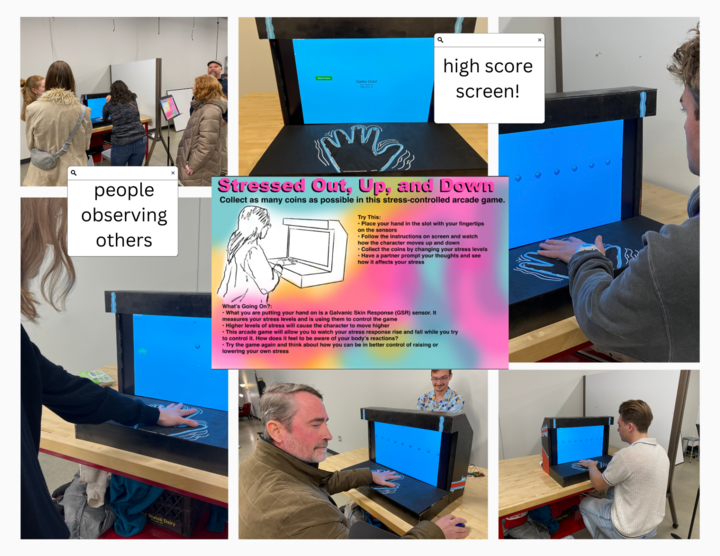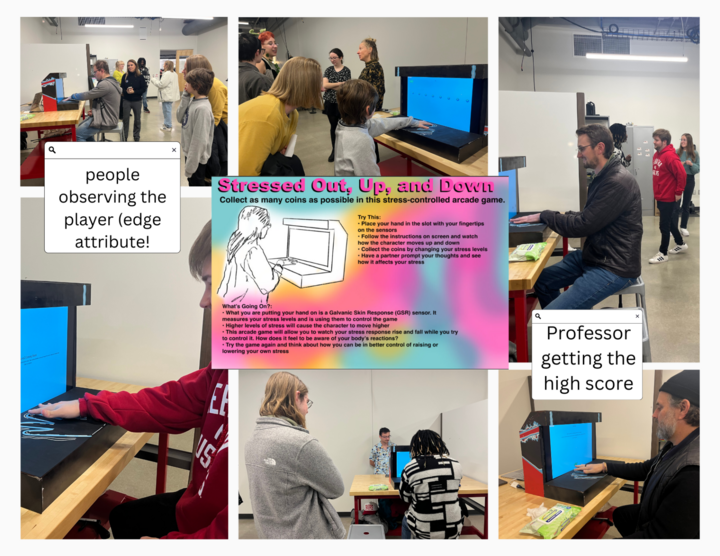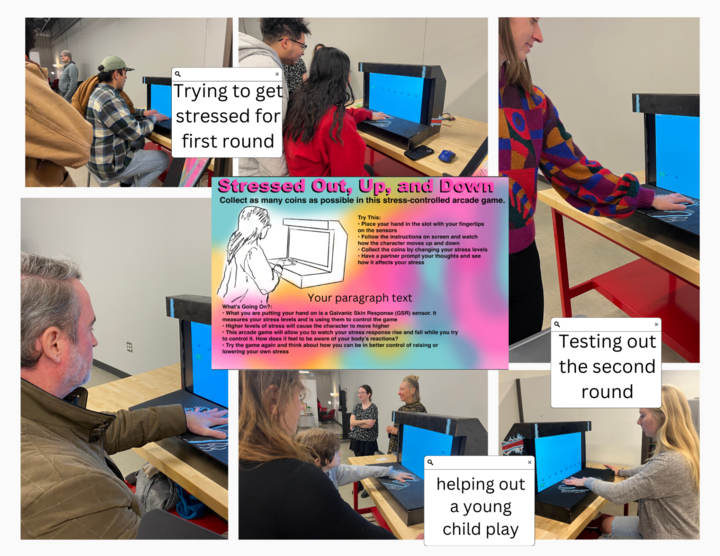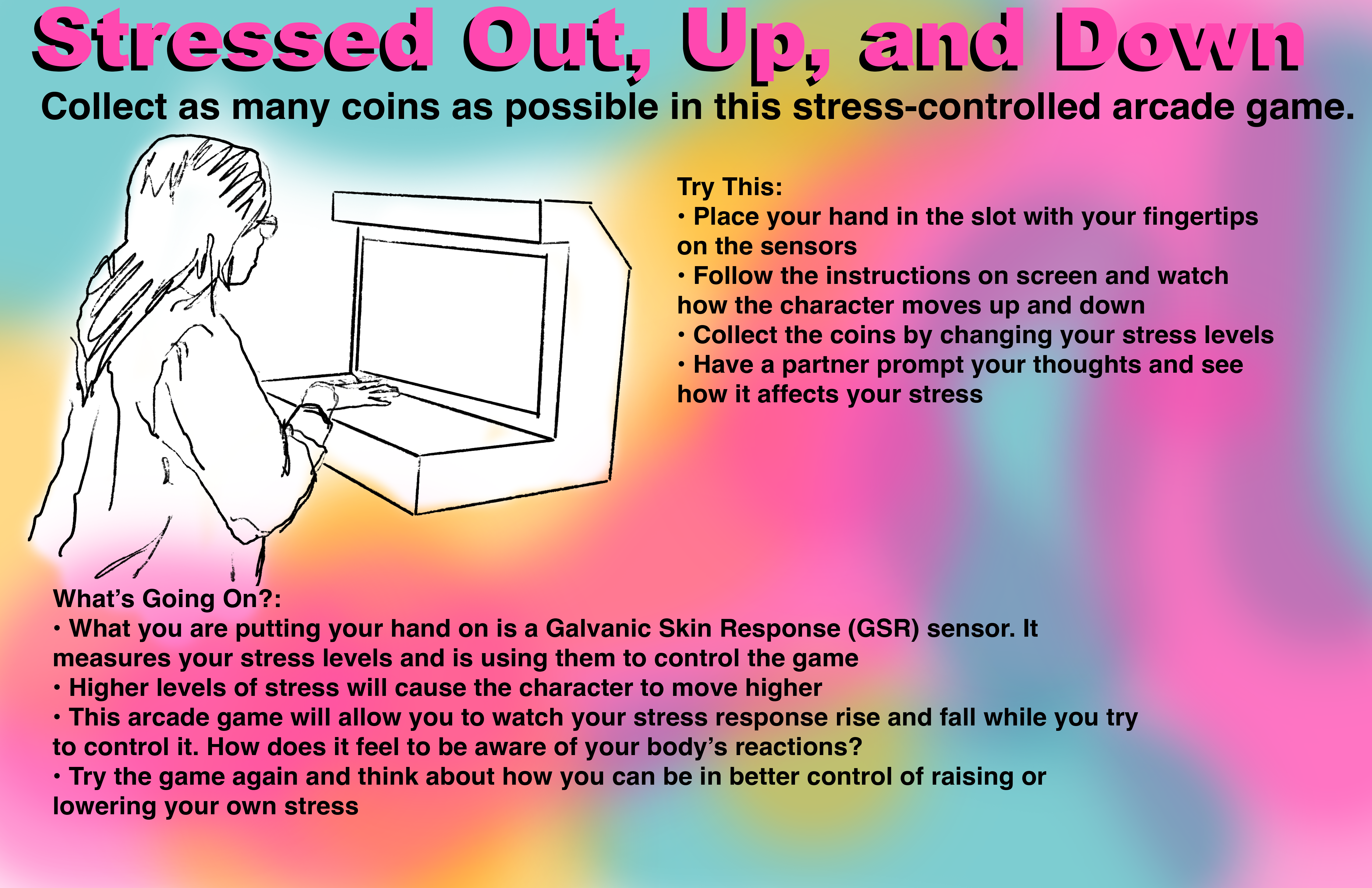Person reference
Date of Exhibition:
Fri, 12/13/2024
Class:
Innovation Studio
Collection:
Feeling stressed is very common among college students, especially during the last few weeks of the semester and finals week. It can be really easy to let that stress build up and not know a good way to relieve it. Our project, Stressed Out, Up, and Down, aimed to have people be aware of their stress levels and learn how they can control it. Inspired by an exhibit at the Luminarium, we looked into how stress can be measured and ways to relieve it. Our research showed us that deep breathing was a great way to feel calm, as well as thinking of calming things. During actual trials, others ways we saw stress greatly get relieved was through laughter and getting a shoulder massage. Stress can be different for different people, so each person may have different ways to feel calm once again.
What we learned from the feedback from people who played our game was that being able to see their stress levels rise and fall via certain stimuli allowed them to think more consciously about how they can control their stress.To get our game to the point where it is now, we went through many iterations. Our first idea was to control the game with your heart rate by wearing a heart rate monitor. After realizing that wouldn’t quite allow a true mindfulness practice, we switched to stress. Using a galvanic skin response (GSR) sensor, we were able to accomplish our goal. But we still had more iterations to get through. The initial idea for the game was similar to Flappy Bird, a mobile game where you, a bird, are trying to fly through a gap between two vertical towers. After playtesting this version and receiving feedback, we decided to move away from it because of the difficulty and likely continuous failing would cause frustration that would skew results.
Our next idea was coin collecting, moving up and down to collect coins. We stuck with this concept, changing the display to a sea turtle collecting bubbles, something we thought would be more calming.Building an interactive science exhibit didn’t come without mild frustration and trials and errors. It was a team effort to get our prototype to look and act the way it finally did. Writing the code for the game was the most difficult part and required multiple team members to complete. Building the display took a collaboration to get the size and assembly as perfect as possible. And playtesting and making changes took everyone so the game would be the most polished it could be.We also needed to be aware of the EDGE Design Attributes to make an exhibit that would be accessible to everyone and draw people in. Our exhibit label showed a picture of what someone playing our game would look like, as well as a description of how to play and what the game was doing. Our exhibit look-and-feel incorporated a familiar object, an arcade display, that most people have seen and would know what to do. It was also playful and whimsical, the design being colorful and having a sea turtle as the character. Finally, the exhibit interactions allowed space for people to watch and learn how to play before their turn, as well as being open ended by the number of coins you collect and how you manage your stress able to be different every play. With these, our exhibit was very successful and allowed people to learn how they could manage their stress, accomplishing our goal.
What we learned from the feedback from people who played our game was that being able to see their stress levels rise and fall via certain stimuli allowed them to think more consciously about how they can control their stress.To get our game to the point where it is now, we went through many iterations. Our first idea was to control the game with your heart rate by wearing a heart rate monitor. After realizing that wouldn’t quite allow a true mindfulness practice, we switched to stress. Using a galvanic skin response (GSR) sensor, we were able to accomplish our goal. But we still had more iterations to get through. The initial idea for the game was similar to Flappy Bird, a mobile game where you, a bird, are trying to fly through a gap between two vertical towers. After playtesting this version and receiving feedback, we decided to move away from it because of the difficulty and likely continuous failing would cause frustration that would skew results.
Our next idea was coin collecting, moving up and down to collect coins. We stuck with this concept, changing the display to a sea turtle collecting bubbles, something we thought would be more calming.Building an interactive science exhibit didn’t come without mild frustration and trials and errors. It was a team effort to get our prototype to look and act the way it finally did. Writing the code for the game was the most difficult part and required multiple team members to complete. Building the display took a collaboration to get the size and assembly as perfect as possible. And playtesting and making changes took everyone so the game would be the most polished it could be.We also needed to be aware of the EDGE Design Attributes to make an exhibit that would be accessible to everyone and draw people in. Our exhibit label showed a picture of what someone playing our game would look like, as well as a description of how to play and what the game was doing. Our exhibit look-and-feel incorporated a familiar object, an arcade display, that most people have seen and would know what to do. It was also playful and whimsical, the design being colorful and having a sea turtle as the character. Finally, the exhibit interactions allowed space for people to watch and learn how to play before their turn, as well as being open ended by the number of coins you collect and how you manage your stress able to be different every play. With these, our exhibit was very successful and allowed people to learn how they could manage their stress, accomplishing our goal.




Project Website: